You could spend a little less or spend a little more and land a more versatile TV.
The Q80B’s quantum dot-enhanced display offers a dependably bright overall picture and terrific highlights during SDR and HDR content. All four of its HDMI 2.1 ports support 4K gaming at 120Hz, and its suite of gaming enhancements rivals that of some flagship-level TVs.
Unfortunately, the Q80B’s overall contrast is squashed on account of its supremely shallow black levels, and its local dimming is brought down by some nasty light bloom that only gets worse during off-axis viewing.
You might have trouble finding a comparably priced TV with better gaming benefits than the Q80B, but you can spend less on a mini-LED TV that delivers better brightness, better contrast, and a more rounded performance profile.
About the Samsung Q80B
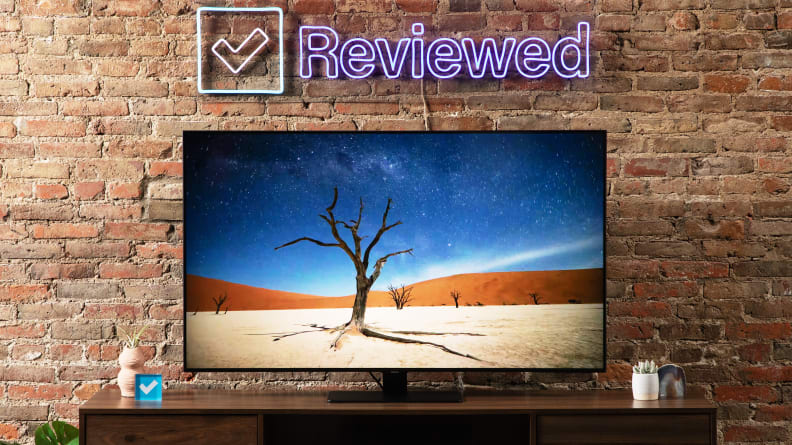
Credit:
Reviewed / Tim Renzi
The Samsung Q80B is available in 50- to 85-inch sizes, some with slightly different display hardware.
The Samsung Q80B is available in five sizes ranging from 50 inches all the way up to 85 inches. Our review unit is a 55-inch model that we purchased ourselves.
Since its release, the Q80B has seen significant discounts. For context, I’ll be listing both the original MSRP of each model as well as its current sale price at the time of publishing.
- 50-inch (Samsung QN50Q80BAFXZA), MSRP $999.99 (on sale for $837.99 at Amazon)
- 55-inch (Samsung QN55Q80BAFXZA), MSRP $1,199.99 (on sale for $877.99 at Amazon)
- 65-inch (Samsung QN65Q80BAFXZA), MSRP $1,499.99 (on sale for $1,097.99 at Amazon)
- 75-inch (Samsung QN75Q80BAFXZA), MSRP $2,199.99 (on sale for $1,597.99 at Amazon)
- 85-inch (Samsung QN85Q80BAFXZA), MSRP $2,299.99 (on sale for $1,997.99 at Amazon)
While we don’t expect there to be major differences in performance from one size to the next, each model is likely equipped with a different amount of dimming zones. A difference in zone count could spell slight differences in how they perform, particularly when it comes to contrast.
In addition, our 55-inch Q80B uses an ADS panel, a variant of the IPS panel type. It is our understanding the smallest and largest sizes use a VA panel instead. Different panel types can affect performance, particularly contrast and off-axis viewing.
Next, let’s take a look at the Q80B’s key hardware and software specifications:
- Resolution: 4K (3,840 x 2,160)
- Display type: Full-array LED with local dimming and quantum dots (ADS-style panel)
- HDR support: HDR10+, HDR10, HLG
- Dolby Atmos: Yes
- eARC support: Yes (HDMI 3)
- Native refresh rate: 120Hz (50-inch model has a 60Hz panel)
- Smart platform: Tizen OS
- Color: DCI-P3 color space/10-bit chroma resolution
- Variable Refresh Rate (VRR): Yes
- Auto Low Latency Mode (ALLM): Yes
- Processor: Quantum Processor 4K
- Other features: AMD FreeSync Premium Pro, Q-Symphony support, Samsung Gaming Hub, Samsung Game Bar, Multi View, Ambient Mode+, Samsung Health, Amazon Alexa, Google Assistant
Like all Samsung TVs, the Q80B does not support Dolby Vision, and instead supports HDR10+, a royalty-free format that uses metadata to optimize the picture in a similar way. Despite the similarities between the two formats, Dolby Vision is still the more prolific format.
The Q80B ships with the newest version of Samsung’s Solar Cell remote control, which features a rechargeable lithium-ion battery that pulls in power from indoor/outdoor light and RF waves from routers. In a pinch, you can charge the remote via its USB-C port.
Connectivity
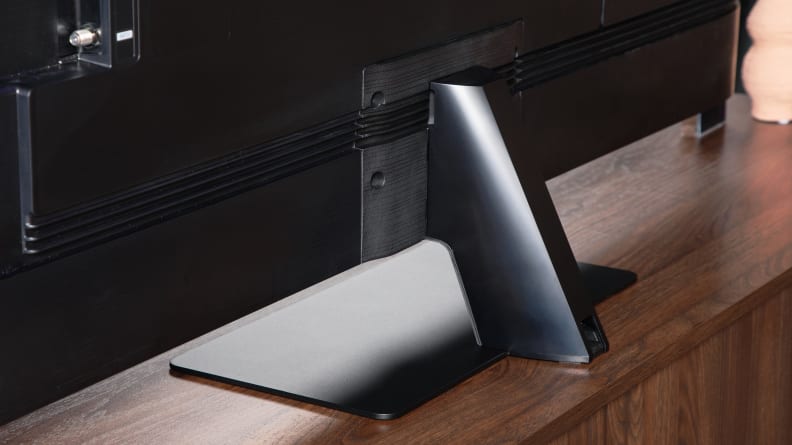
Credit:
Reviewed / Tim Renzi
The Q80B’s plate-style stand connects to the back of the panel and is equipped with a cover for cable management.
The Q80B is loaded with A/V connectivity options for casual viewers and power users alike. Here’s what you’ll find in a cutout on the rear of the panel:
- 4x HDMI 2.1 (4K @ 120Hz, 1x HDMI ARC/eARC)
- 2x USB 2.0
- RF connection (cable/antenna)
- Ethernet (LAN) input
- Digital audio output (optical)
Performance Data
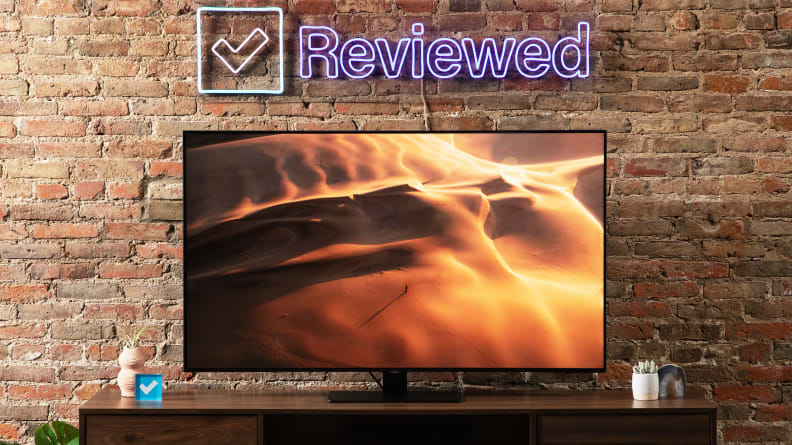
Credit:
Reviewed / Tim Renzi
We started with the Q80B’s Filmmaker picture mode for both SDR and HDR tests, ensuring an accurate assessment.
Before testing each TV, we make sure the panel is on and receiving a continuous signal for at least 2 hours. Our 55-inch Q80B received this standard warm-up time before any readings were taken. In addition, the TV received the latest firmware updates at the time of testing.
For both SDR and HDR tests, we’re using the Q80B’s Filmmaker picture mode. We’ve chosen this setting because of its accuracy, but performance may vary depending on which picture mode is enabled. For example, you might experience a brighter picture with a different mode enabled, but it may negatively affect color temperature and overall color accuracy.
For additional context, I also ran some tests in the TV’s Movie picture mode, but those results are not reported below.
To get a sense of the TV’s average performance, we use a standard ANSI checkerboard pattern for most of our basic contrast tests. We also use white and black windows ranging from 2% to 90% to test how well the contrast holds up while displaying varying degrees of brightness.
Our peak brightness measurements are taken with sustained windows to represent the TV’s peak brightness over a sustained period of time. Specular highlights (like brief flashes of reflected light) might reach higher brightness levels, but not for sustained periods of time.
All of our tests are created with a Murideo Seven 8K signal generator and tabulated via Portrait Displays’ Calman Ultimate color calibration software.
I’ll expand on our test results throughout the review, but for now, here are some key takeaways:
- HDR contrast (brightness/black level): 487.9 nits/0.412 nits (ANSI checkerboard)
- SDR contrast (brightness/black level): 449.7 nits/0.408 nits (ANSI checkerboard)
- HDR peak brightness (sustained): 732.7 nits (2% white window)
- HDR color gamut coverage (DCI-P3/10-bit): 86%
- SDR color gamut coverage (Rec.709): 99%
Before testing, I disabled the TV’s Brightness Optimization setting to ensure that the Q80B wasn’t adjusting its picture based on our dark-room testing conditions. This setting can be found in the TV’s Power and Energy Saving submenu.
To get a clear understanding of the Q80B’s maximum brightness, I conducted SDR tests with the Brightness slider set to its maximum (50). For all tests, Local Dimming was set to High, Color Tone was set to Warm2, while Film Mode, Contrast Enhancer, and all Picture Clarity settings were disabled.
What we like
Bright and colorful picture makes for great daytime viewing
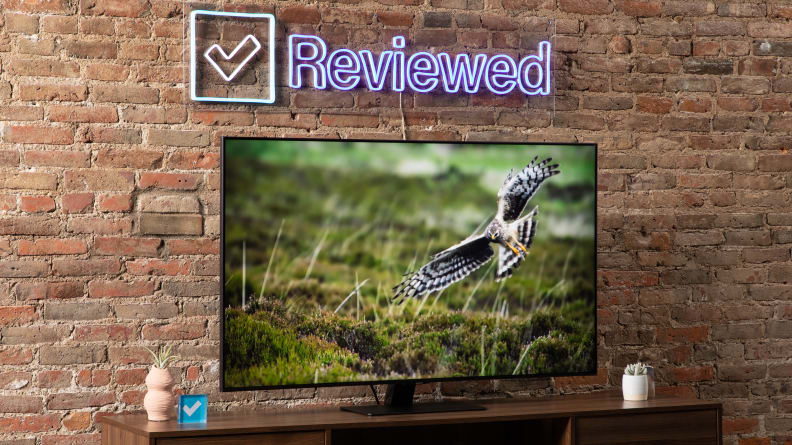
Credit:
Reviewed / Tim Renzi
The Q80B is bright enough for daytime viewing—so long as it’s not sitting directly in a sunbeam.
The Q80B is the brightest Samsung TV you can get without climbing up into the higher-end Neo QLED class. As a standard Samsung QLED, it doesn’t offer the same mini-LED backlight, but brightness- and color-boosting quantum dots are along for the ride.
According to our test results, there isn’t much of a difference between the Q80B’s SDR and HDR peak brightness. Even in the TV’s carefully calibrated Filmmaker mode, the Q80B is bright enough to stand out in a sunny living room, with specular highlights routinely climbing into the 700- to 800-nit range.
The Q80B isn’t as colorful as some of its competitors, but its quantum-dot display delivers a pleasing palette that most people will appreciate. According to our measurements, it covers about 86% of the HDR color space (DCI-P3), and the Q80B features a fairly accurate out-of-the-box calibration in both FIlmmaker and Movie mode. For reference, the TCL 6-Series covers about 92% of DCI-P3, and the Hisense U8H comes in at around 97%. The Q80B’s colors aren’t as punchy as those two friendlier-priced TVs, but its picture processing and overall brightness help to maintain a clean, pleasant-looking expression.
Viewers on the hunt for the brightest and most colorful picture in this price range might be better off exploring some of the Q80B’s competitors, but folks looking for a non-flagship Samsung TV that holds up in bright rooms will appreciate the look of the Q80B. It’s a dependable daytime TV, regardless of whether you’re gaming, watching cable, or streaming movies.
A robust selection of gaming-friendly features
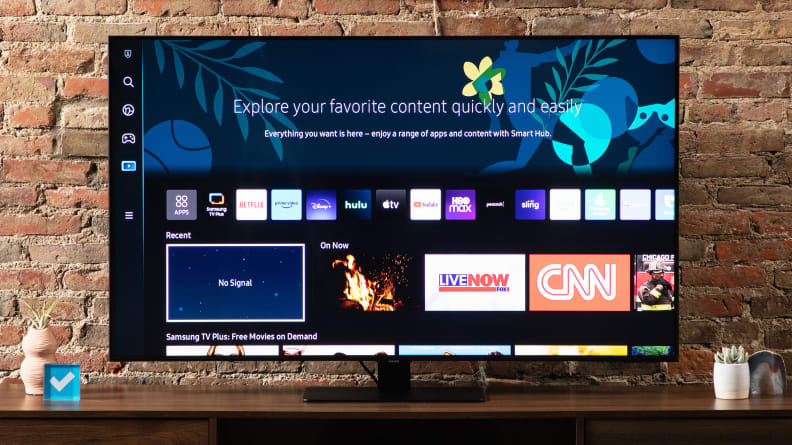
Credit:
Reviewed / Tim Renzi
The Q80B delivers a host of gaming-friendly features across all four of its HDMI 2.1 ports.
Speaking of video games, the Q80B has a significant gaming advantage over some of the aforementioned competition: full HDMI 2.1 support across all four of its inputs.
While TVs like the Hisense U8H and the TCL 6-Series only feature two inputs that support 4K gaming at 120Hz, the Q80B is equipped with four. Additionally, all of these ports offer Auto Low Latency Mode (ALLM), Variable Refresh Rate (VRR), and FreeSync Premium Pro for a consistently smooth, seamless gaming experience. This level of gaming support is typically reserved for higher-end models, and even some top-tier flagships don’t offer this amount of flexibility. I should point out that the 50-inch model has a 60Hz panel, so it can’t take advantage of 120Hz gaming.
Its gaming features don’t stop there: Like many Samsung TVs, the Q80B is also equipped with Game Bar, a menu that offers a variety of gaming-related picture and performance settings. You can adjust the picture based on game type, check the current framerate, enable VRR, and more—all from an easily accessible menu on the bottom of the screen.
The Q80B also supports Samsung Gaming Hub, a software package that offers a number of cloud gaming services, including Nvidia GeForce Now and Xbox Cloud Gaming. Essentially, Gaming Hub lets you stream video games right to your TV—no console required. We had our reservations about the service when we tested it at launch last year, but it’s a cool feature to have in your back pocket, especially if its performance improves with time.
The Q80B’s suite of gaming-related hardware and software enhancements is arguably its biggest strength. If you’re looking for a brighter-than-average TV for daytime gaming and you don’t want to jump up to the highest price bracket, the Q80B is one of the best options available.
What we don’t like
Poor overall contrast and distracting light bloom
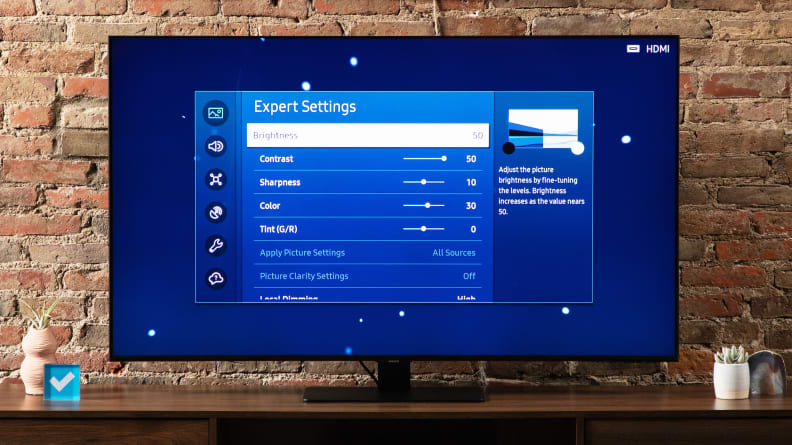
Credit:
Reviewed / Tim Renzi
The Q80B’s weakest area of performance is its overall contrast. Its black levels aren’t nearly as deep as some competitive TVs in its class.
If gaming features are the Q80B’s biggest strength, its Achilles’ heel is its overall contrast; the TV is fairly bright, but its black levels are very shallow. So shallow, in fact, that large swaths of dark (like night skies and shadowy interiors) appear more gray than black. In those situations, the Q80B’s black levels settle into the 0.3- to 0.4-nit range. By comparison, the TCL 6-Series and the Hisense U8H measure just below 0.1 nits.
Now, to be fair, both of those TVs are equipped with mini-LED backlighting, a fancier display technology that inherently delivers better contrast. Even more impactful are those TVs’ VA-style panels, which are capable of delivering better overall contrast than our 55-inch Q80B’s ADS-style panel. But, crucially, these competitive TVs are both more affordable than the Q80B.
Typically, ADS-style panels outpace their VA-style counterparts in the viewing angle department. And while the Q80B is mostly free of color-shifting during off-axis viewing, other aspects of the picture aren’t spared. The Q80B exhibits an unhealthy amount of light bloom—particularly during dark scenes—when viewed just 20 degrees off-center. It’s yet another area of performance where more-affordable mini-LED TVs outpace the Q80B.
Given these limitations, I would not recommend the Q80B to viewers who frequently watch and game in the dark, especially if your intention is to buy a 65-inch TV. It’s not a good pick for big-screen group viewings after dark.
Abundant features are stifled by slow software
Beyond its myriad gaming features, the Q80B is stuffed with miscellaneous, day-to-day features to accommodate modern living: Samsung Health for mental and physical fitness tracking, Q-Symphony support for soundbar harmonization, and Multi View for dual-screen coordination. It’s all part of Samsung Smart Hub, a platform with all of the usual suspects—Netflix, YouTube, Disney+, for example—as well as an array of downloadable apps to expand your options.
While the breadth of content and bonus features are appreciated, the sludgy software that supports it all is not. As with nearly every Samsung TV I’ve tested in the last year, the Q80B lacks the snap and nimbleness of Roku and Google TV.
It’s at its worst when you’re doing quick, rapid scrolling through tiles of content or on-screen keys. Sometimes pressing a button four times will result in only three inputs, while other times a slight delay in feedback will cause one too many button presses. It’s a maddening dance when all you’re trying to do is type in a Wi-Fi password or scroll to the bottom of a list of TV shows.
The TV’s menu organization is odd, too; accessing various HDMI inputs requires on-screen hoop-jumping, as there’s no proper source button on the remote control. Accessing the full settings menu can’t be done with a single press, either; you have to access it from the TV’s home screen or expand an abbreviated list of settings. No matter which path you opt for, it’ll take multiple button presses.
Wobbly design
The Q80B’s pedestal-style stand connects a thin, flat base to the back of the panel and houses a basic cable management system. The best I can say about the design is that it offers a decent amount of clearance for a soundbar and it looks fine at a glance. Unfortunately, the weight of the panel and the dimensions of the stand cause the panel to wobble whenever it’s disturbed.
Should you buy the Samsung Q80B?
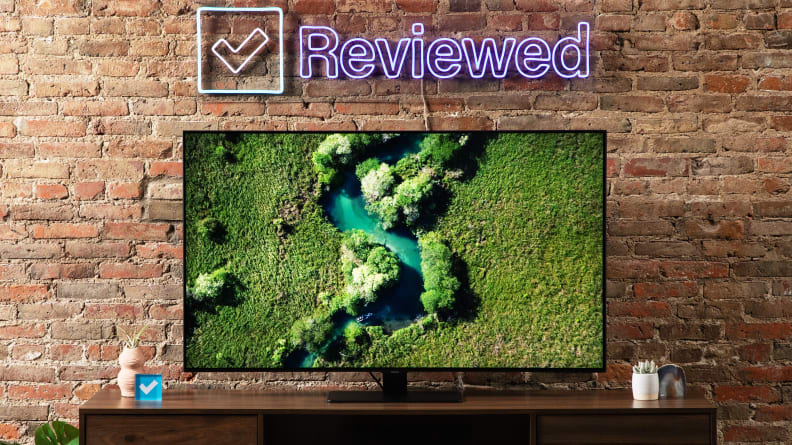
Credit:
Reviewed / Tim Renzi
The Samsung Q80B is a powerful gaming TV, but most people (including gamers) can secure a better all-around TV for less.
Maybe, but only if you want a powerful gaming TV for less than the price of a flagship
The ideal Samsung Q80B owner is one who does most of their viewing during the day, who owns multiple gaming consoles, and who doesn’t want to splurge on a top-shelf option like the Samsung QN90B or the Samsung S95B.
On paper, the Q80B’s fully-loaded HDMI 2.1 support, its 120Hz refresh rate, and its array of additional gaming features make it one of best gaming TVs in its price range. Unfortunately, its shallow black levels and aggressive light bloom undercut its gaming prowess—it’s just not a very good dark-room TV.
Not only are the TCL 6-Series and the Hisense U8H brighter, they deliver better black levels and contrast control thanks to their mini-LED displays, and better software, to boot. Right now, you can get both of these TVs for less than the cost of a Q80B.
The Q80B is a decent TV, but you can spend a little less or spend a little more and wind up with something that better suits your needs.
The product experts at Reviewed have all your shopping needs covered. Follow Reviewed on Facebook, Twitter, Instagram, TikTok, or Flipboard for the latest deals, product reviews, and more.
Prices were accurate at the time this article was published but may change over time.
Meet the tester
Michael Desjardin graduated from Emerson College after having studied media production and screenwriting. He specializes in tech for Reviewed, but also loves film criticism, weird ambient music, cooking, and food in general.
Checking our work.
Our team is here for one purpose: to help you buy the best stuff and love what you own. Our writers, editors, and lab technicians obsess over the products we cover to make sure you’re confident and satisfied. Have a different opinion about something we recommend? Email us and we’ll compare notes.











